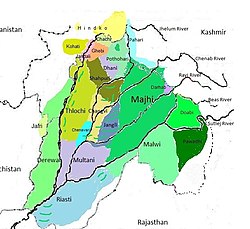| Punjabi languages | |
|---|---|
| Geographic distribution | Punjab, Jammu and Kashmir, Khyber Pakhtunkhwa, Delhi, Haryana, Rajasthan and Himachal Pradesh |
| Ethnicity | Punjabis |
| Linguistic classification | Indo-European
|
Early form | |
| Language codes | |
| Glottolog | lahn1241 |
| Part of a series on |
| Punjabis |
|---|
 |
 Punjab portal |
The Punjabi dialects and languages or Greater Panjabic are a series of dialects and Indo-Aryan languages spoken around the Punjab region of Pakistan and India with varying degrees of official recognition. [7] They have sometimes been referred to as the Greater Punjabi macrolanguage. [8] Punjabi may also be considered as a pluricentric language with more than one standard variety. [9]
Contents
- Geographic distribution
- Pakistan
- India
- List of dialects and varieties
- Central Punjabi
- Eastern Punjabi
- Western Punjabi
- Hindko
- Pahari-Pothwari
- Saraiki
- Extinct Dialects
- See also
- References
- Sources
- External links

Punjabi is a language spoken primarily in the Punjab region, which is divided between India and Pakistan. It is also spoken by Punjabi diaspora communities around the world. Punjabi itself has several dialects that can vary based on geographical, cultural, and historical factors.
The varieties of "Greater Punjabi" have a number of characteristics in common, for example the preservation of the Prakrit double consonants in stressed syllables. [10] Nevertheless, there is disagreement on whether they form part of a single language group, with some proposed classifications placing them all within the Northwestern zone of Indo-Aryan, while others reserving this only for the western varieties, and assigning the eastern ones to the Central zone alongside Hindi. [11]